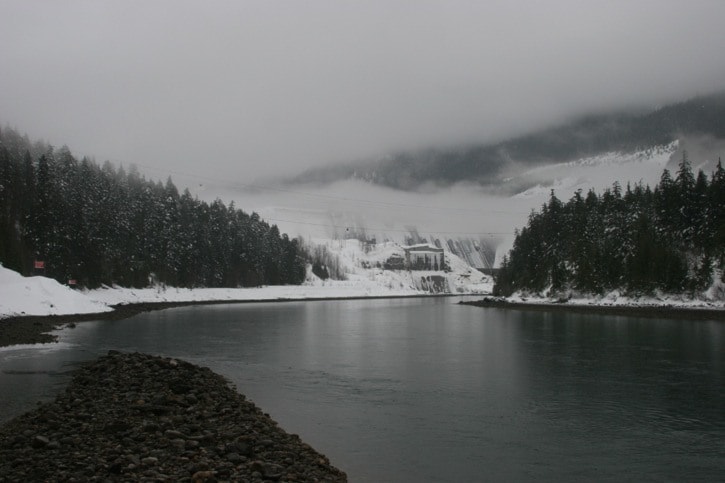The Revelstoke Dam is now being run at minimum flow levels in order to benefit fish and fish habitat in the Columbia River, BC Hydro announced.
The dam is releasing water at a minimum rate of 142 cubic metres per second as recommended by the 2007 Columbia Water Use Plan (WUP). The minimum flow is expected to benefit a variety of fish species such as mountain whitefish, burbot, rainbow trout, bull trout and white sturgeon.
“Water flows in the mid-Columbia River downstream from the Revelstoke Dam are highly variable,” said Karen Bray, BC Hydro natural resource specialist in a news release. “The minimum flow is intended to benefit production in the river from the bottom to the top of the fish food chain by providing a minimum amount of continuously wetted river habitat. Our monitoring program will evaluate this by comparing river productivity across the range of BC Hydro’s Revelstoke Dam operations both with and without the minimum flow.”
As part of the WUP, BC Hydro will monitor productivity in the river for the next nine years with minimum flows in place. The data will be compared with information gathered over the past four years prior to minimum flows being put in place.
The benefits are expected to be greatest in the river from the Revelstoke Dam to the Illecillewaet River, BC Hydro said.
The following is a story by Times Review nature columnist Michael Morris that appeared in the Oct. 20, 2010, issue of the newspaper:
Dozens of orange floats sway in the current of the Columbia River as it streams past Revelstoke. They mark the location of metal frames and cages secured to the river bed to collect samples of what lives in the river bed below the Revelstoke Dam.
The frames are meant to collect algae and microscopic organisms at the base of the aquatic food chain. The cages of gravel will become a home to creatures large enough to see — stoneflies, caddis flies, mayflies. Measuring the river’s biological productivity is a way to assess the management regime of the Revelstoke Dam in regards to aquatic ecology.
These instruments are part of a thirteen-year BC Hydro study led by Karen Bray. She oversees the contractors who install and monitor these river bed samplers. These biologists work late at night when the water from the dam is shut off. The sample collectors are precisely placed to provide the data that will later contribute to a three dimensional map of what lives in the river.
As a consequence of BC Hydro’s public consultations, there will be a minimum flow of 5,000 cubic feet per second from the dam beginning this fall. This has never happened before. Up to now BC Hydro shuts off the water when power demand was low, often not generating power at night or on weekends. The benefit of minimum flow will be judged by measuring what lives there now and then comparing that with what lives there later.
These studies will assess trends in fish populations as well as the energy requirements of bull trout and mountain whitefish to see if there are changes as a result of the minimum flow. These fish, as well as kokanee, rainbow trout, and sturgeon, are part of a larger aquatic ecosystem that extends into the Arrow Reservoir. Many of these fish migrate south into the deeper water for the winter and return upstream in the spring.
Prior to the construction of the Mica and Revelstoke dams, the river experienced spring floods that moved large boulders, eroded banks, and toppled trees into the river creating habitat complexity and a surge of nutrients. The Columbia River used to drop its sediment load in the original Arrow Lakes. Now those sediments are left in the reservoirs, resulting in abnormally clear water for such a large river.
With the operation of the fifth turbine at the Revelstoke Dam expected sometime this fall, maximum flow will increase from 60,000 to 75,000 cubic feet per second. The resulting swings in flow past Revelstoke from daytime maximums to night-time minimums will be of interest to river watchers and scientists.
Will an assured minimum flow nurture the base of this aquatic food chain? If it does, there will be more small fish, which support larger fish, which in turn are food for top predators. Look for the more obvious river dependent residents— osprey, eagles, bears, otters, gulls, kingfishers, which feed in or along the river that passes through our town.
